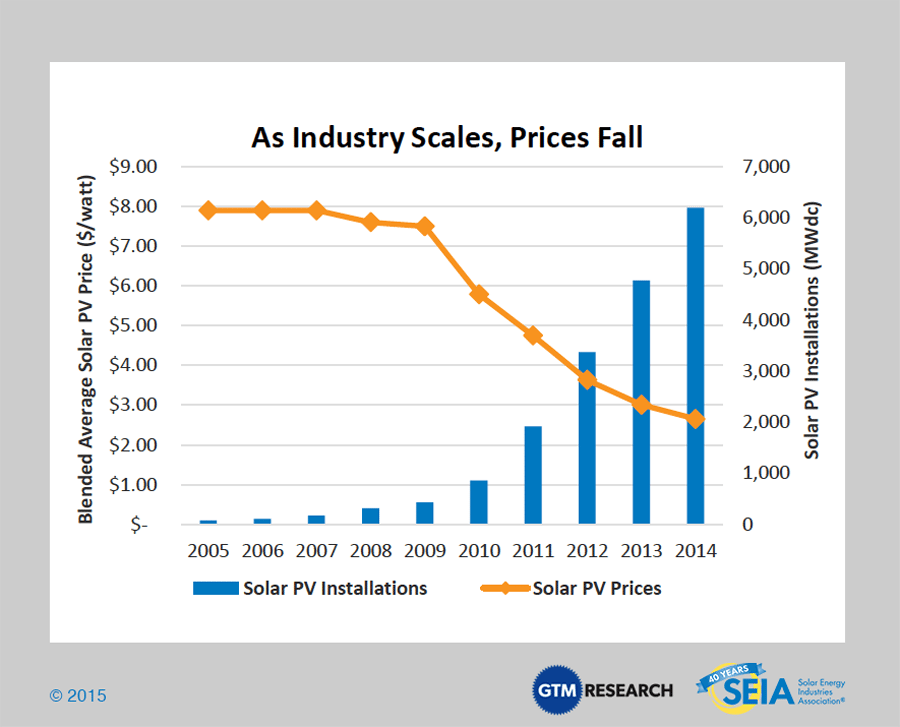Solar energy is the fastest growing source of electricity in the U.S. Last year, the amount of solar capacity installed in the U.S. every three weeks was equivalent to the entire amount of solar capacity installed for the year in 2008. Not only is the solar energy industry rapidly expanding, but also costs are dramatically declining. Since 2008, the cost of photovoltaic (PV) panels has declined by over 80 percent.
The growth of the solar energy industry is great news for not only the environment — because the production of solar energy creates no emissions and relies on a free fuel source — but also for Americans’ pocketbooks. By generating one’s own electricity through solar PV, energy consumers can reduce their electricity bills. However, policies and programs that help offset the capital costs of installation for solar PV are crucial in customer’s ability to fully financially benefit from generating their own solar energy.
The decline in costs for solar have ushered in a solar boom in the U.S., but not for everyone. According to the GW Solar Institute, the 49.1 million households that earn less than $40,000 per year make up 40 percent of all U.S. households but only account for less than 5 percent of solar installations. Electricity costs account for 5.7 percent of the median low-income family’s budget while only accounting for 1.9 percent of other families’ budgets.
Low-income households could greatly benefit from installing a distributed PV system where a 4 kW system generates between 5,000 and 6,000 kWh of electricity each year. This amount of electricity would be enough to cover more than half of the typical low-income household’s electricity needs.
RELATED: ‘Dark Money’ Fighting Against Solar Energy Exposed
Barriers to the growth of solar energy on low-income households include the fact that low-income households are less likely to own their own roof (are renters), lack the funds for the capital cost of solar PV system, poor state or utility programs and policies for distributed solar energy and a lack of information on how to transition to solar energy.
RELATED: Georgia Legislature Unanimously Approves Third-Party-Owned Rooftop Solar
Fortunately, the Obama administration recently announced a new initiative to increase solar access for all Americans. Specifically, several executive actions are aimed at scaling up solar in low and moderate income communities and households:
- Setting a goal to install 300 MW of renewable energy in federally subsidized housing: The Administration set a goal to install 300 MW, including community and shared solar installations, of renewable energy by 2020.
- Launging a community solar partnership: Community solar is an installation that accepts capital from and provides output credit and tax benefits to individual and other investors. In some systems you buy individual solar panels which are installed in the farm after your purchase. In this plan, the U.S. Department of Energy (DOE) in collaboration with the Department of Housing and Urban Development (HUD), the U.S. Department of Agriculture (USDA), the EPA, solar companies, nonprofit groups and state and community leaders will create a partnership to leverage the interest in the public and private sector to expand access to community solar for low and moderate income households and communities.
- Developing a toolkit to increase the ability of states to use Federal funding to deploy solar on affordable housing: HUD will release a renewable energy toolkit for use by Community Planning and Development grantees to make it easier to use Section 108 Community Development Block Grant funds for solar systems.
- Providing technical assistance to make it easier to install solar on affordable housing: HUD will offer direct technical assistance to affordable housing organizations making a commitment to the new 300 MW goal.
RELATED: In July, Bernie Sanders introduced the Low Income Solar Act
The continued momentum of the current solar boom must include installations — either on site or through community solar and similar programs — that benefit low and moderate income households. The recent announcement by the Obama administration is an important and crucial step at the federal level to grow solar in low and moderate income households, especially where the 30 percent solar investment tax credit is due to expire in 2016.



